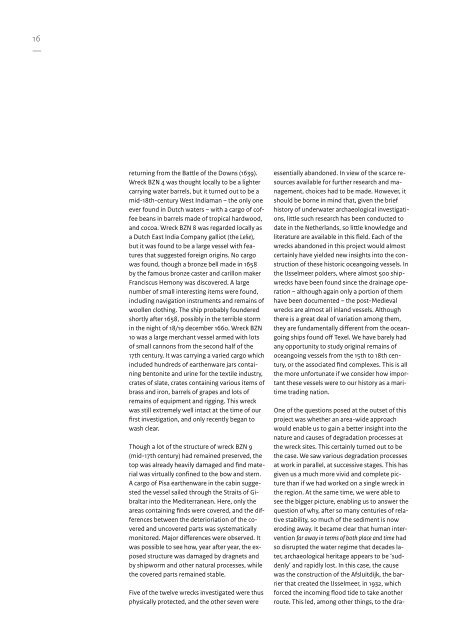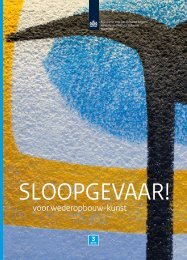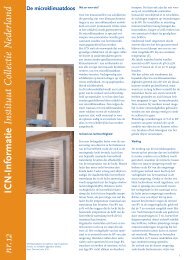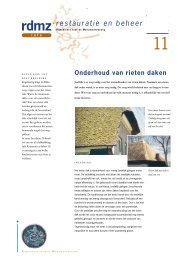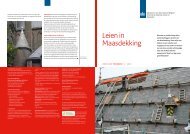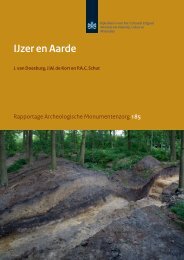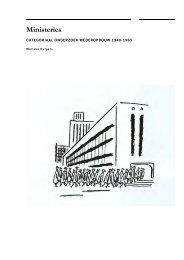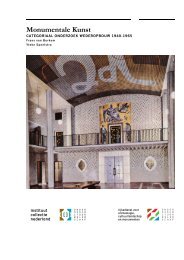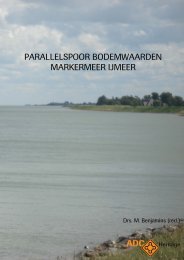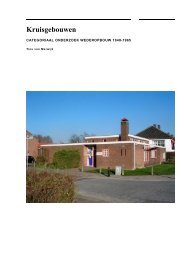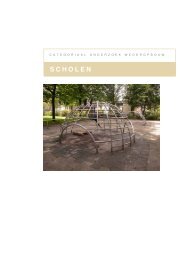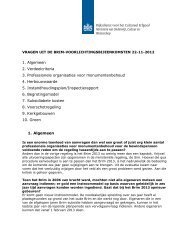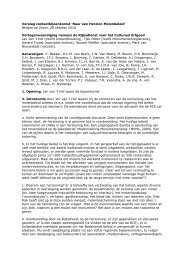Burgzand - Rijksdienst voor het Cultureel Erfgoed
Burgzand - Rijksdienst voor het Cultureel Erfgoed
Burgzand - Rijksdienst voor het Cultureel Erfgoed
Create successful ePaper yourself
Turn your PDF publications into a flip-book with our unique Google optimized e-Paper software.
16<br />
—<br />
returning from the Battle of the Downs (1639).<br />
Wreck BZN 4 was thought locally to be a lighter<br />
carrying water barrels, but it turned out to be a<br />
mid-18th-century West Indiaman – the only one<br />
ever found in Dutch waters – with a cargo of coffee<br />
beans in barrels made of tropical hardwood,<br />
and cocoa. Wreck BZN 8 was regarded locally as<br />
a Dutch East India Company galliot (the Lelie),<br />
but it was found to be a large vessel with features<br />
that suggested foreign origins. No cargo<br />
was found, though a bronze bell made in 1658<br />
by the famous bronze caster and carillon maker<br />
Franciscus Hemony was discovered. A large<br />
number of small interesting items were found,<br />
including navigation instruments and remains of<br />
woollen clothing. The ship probably foundered<br />
shortly after 1658, possibly in the terrible storm<br />
in the night of 18/19 december 1660. Wreck BZN<br />
10 was a large merchant vessel armed with lots<br />
of small cannons from the second half of the<br />
17th century. It was carrying a varied cargo which<br />
included hundreds of earthenware jars containing<br />
bentonite and urine for the textile industry,<br />
crates of slate, crates containing various items of<br />
brass and iron, barrels of grapes and lots of<br />
remains of equipment and rigging. This wreck<br />
was still extremely well intact at the time of our<br />
first investigation, and only recently began to<br />
wash clear.<br />
Though a lot of the structure of wreck BZN 9<br />
(mid-17th century) had remained preserved, the<br />
top was already heavily damaged and find material<br />
was virtually confined to the bow and stern.<br />
A cargo of Pisa earthenware in the cabin suggested<br />
the vessel sailed through the Straits of Gibraltar<br />
into the Mediterranean. Here, only the<br />
areas containing finds were covered, and the differences<br />
between the deterioriation of the covered<br />
and uncovered parts was systematically<br />
monitored. Major differences were observed. It<br />
was possible to see how, year after year, the exposed<br />
structure was damaged by dragnets and<br />
by shipworm and other natural processes, while<br />
the covered parts remained stable.<br />
Five of the twelve wrecks investigated were thus<br />
physically protected, and the other seven were<br />
essentially abandoned. In view of the scarce resources<br />
available for further research and management,<br />
choices had to be made. However, it<br />
should be borne in mind that, given the brief<br />
history of underwater archaeological investigations,<br />
little such research has been conducted to<br />
date in the Netherlands, so little knowledge and<br />
literature are available in this field. Each of the<br />
wrecks abandoned in this project would almost<br />
certainly have yielded new insights into the construction<br />
of these historic oceangoing vessels. In<br />
the IJsselmeer polders, where almost 500 shipwrecks<br />
have been found since the drainage operation<br />
– although again only a portion of them<br />
have been documented – the post-Medieval<br />
wrecks are almost all inland vessels. Although<br />
there is a great deal of variation among them,<br />
they are fundamentally different from the oceangoing<br />
ships found off Texel. We have barely had<br />
any opportunity to study original remains of<br />
oceangoing vessels from the 15th to 18th century,<br />
or the associated find complexes. This is all<br />
the more unfortunate if we consider how important<br />
these vessels were to our history as a maritime<br />
trading nation.<br />
One of the questions posed at the outset of this<br />
project was w<strong>het</strong>her an area-wide approach<br />
would enable us to gain a better insight into the<br />
nature and causes of degradation processes at<br />
the wreck sites. This certainly turned out to be<br />
the case. We saw various degradation processes<br />
at work in parallel, at successive stages. This has<br />
given us a much more vivid and complete picture<br />
than if we had worked on a single wreck in<br />
the region. At the same time, we were able to<br />
see the bigger picture, enabling us to answer the<br />
question of why, after so many centuries of relative<br />
stability, so much of the sediment is now<br />
eroding away. It became clear that human intervention<br />
far away in terms of both place and time had<br />
so disrupted the water regime that decades later,<br />
archaeological heritage appears to be ‘suddenly’<br />
and rapidly lost. In this case, the cause<br />
was the construction of the Afsluitdijk, the barrier<br />
that created the IJsselmeer, in 1932, which<br />
forced the incoming flood tide to take another<br />
route. This led, among other things, to the dra-


